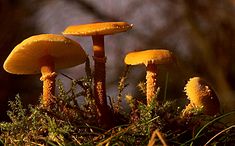- Cystoderma amianthinum
-
Cystoderma amianthinum 
Conservation status commonScientific classification Kingdom: Fungi Division: Basidiomycota Class: Agaricomycetes Order: Agaricales Family: Agaricaceae Genus: Cystoderma Species: C. amianthinum Binomial name Cystoderma amianthinum
(Scop.) FayodCystoderma amianthinum Mycological characteristics 
gills on hymenium 

cap is convex
or umbonate
hymenium is adnexed 
stipe has a ring 
spore print is white 
edibility: unknown Cystoderma amianthinum, commonly called the saffron parasol, the saffron powder-cap, or the earthy powder-cap, is a small orange-ochre, or yellowish-brown, gilled mushroom. It grows in damp mossy grassland, in coniferous forest clearings, or on wooded heaths. It is probably the most common of the small Cystoderma genus. Possibly edible, it is not recommended due to its unpleasant odour and resemblance to poisonous species.
Contents
Taxonomy
Cystoderma amianthinum was first noted by the Italian-Austrian naturalist Giovanni Antonio Scopoli, who called it Agaricus amianthinus in 1772. The present generic name Cystoderma was erected by Swiss mycologist Victor Fayod in 1889, and is roughly translated as 'Blistered skin', and is probably a reference to the appearance of the pellicle (cap skin).[1]
Description
The cap is usually between 2 and 5 cm (0.8–2 in) in diameter, convex to bell-shaped, and later flat with a slight depression around a low umbo (central boss). It is dry and powdery, often with a shaggy or fringed margin (appendiculate), and is saffron yellow or orange-ochre. The stem is cylindrical, and has a flaky-granular sheath beneath a fleeting, powdery ring. The gills are white initially, and become creamy later. They are adnexed (narrowly attached to the stem), and initially quite crowded.[2] The spore print is white.[3] The flesh is thin and yellowish, with an unpleasant mouldy smell.
A very similar form with a markedly radially wrinkled cap, has been separated by some authors, and given the binomial Cystoderma rugoso-reticulatum.[2]
Cystodermella granulosa, and Cystodermella cinnabarina are both redder as a rule, and have adnate gills (broadly attached to the stem).[3]
Distribution and habitat
Cystoderma amianthinum is widespread in Europe and North America, and common in northern temperate zones. It occurs in mossy woodland, on heaths, amongst grass or bracken, and sometimes with willow.[4] It is often found on acidic soils.[5]
Edibility
Cystoderma amianthinum is said to be edible, but hardly worthwhile, and caution is strongly advised. It resembles the small poisonous members of the genus Lepiota.
References
- ^ David Arora (1986). Mushrooms Demystified. Ten Speed Press. ISBN 0-89815-169-4.
- ^ a b Helmut and Renate Grunert (1992). Field Guide to MUSHROOMS of Britain and Europe (English Edition). The Crowood Press Ltd. ISBN 1 85223 592 6.
- ^ a b Roger Phillips (2006). Mushrooms. Pan MacMillan. p. 138. ISBN 0-330-44237-6.
- ^ Thomas Laessoe (1998). Mushrooms (flexi bound). Dorling Kindersley. ISBN 0-7513-1070-0.
- ^ Regis Courtecuisse and Bernard Duhem ((British version) 1995). Mushrooms and Toadstools of Britain and Europe. Harper Collins. ISBN 0 00 220025 2.
Categories:- Agaricaceae
- Fungi of Europe
- Fungi of North America
- Edible fungi
Wikimedia Foundation. 2010.
